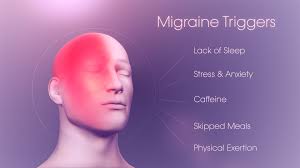Migraine
Migraine is a type of headache. It comes with severe throbbing pain or a pulsing sensation, usually on just one side of the head and is often accompanied by nausea, vomiting and extreme sensitivity to light and sound. Migraine attacks can cause significant pain lasting for hours, sometimes even days. The pain can be so severe that it can adversely affect a person’s day-to-day functioning and quality of life. Usually, some warning symptoms, also known as the aura, occur before the start of the actual pain attack. Auras can occur before or during the migraine attack. Typically, these include seeing flashes of light or blind spots or tingling on one side of the face or in either of the arms or legs. The symptoms vary from person to person, with different symptoms for each time. Migraine attacks may differ in length and frequency too, usually lasting from 4 to 72 hours. Most people are free from symptoms between the attacks.
The two most common types of migraine are migraine with aura and migraine without aura. Medications can cure some migraines and make them less painful.

